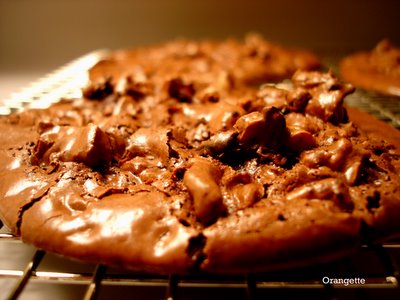When disappointment comes to dinner
With the possible exceptions of war, loss, loneliness, homelessness, natural disasters, incurable diseases, hunger, heartbreak, income taxes, yeast infections, and the horrifyingly botched haircut I got last October, there is nothing worse than a bad recipe. Nothing. That’s a strong statement, I know, but test it for yourself—or sit back and wait, because a bad one is bound to find you—and you’ll no doubt agree. There is nothing worse than a recipe that goes all wrong, or that never quite makes it to right. Disappointment, dear reader, is a total dud of a dinner companion.
For the most part, I try to forget about the flops, the bummers, and the busts. They’re pretty few and far between, anyway, and often easy to sniff out. And when a bad recipe does manage to sneak past the guards, in most cases no permanent damage is done—unless, of course, the culprit calls for caviar, truffles, or gold leaf. By dint of willful memory loss or welcome amnesia, I return to the kitchen largely unscarred, day after day.
But the few calamities that do linger, however, tend to involve baking, a strict science in which the simplest mistake or misdirection is magnified exponentially by the oven’s heat and a hungry sweet tooth. Take, for example, the towering lemon meringue tart that wept—nay, sobbed—onto my kitchen counter so aggressively that I had to position it atop a protective layer of newspaper as though potty-training a puppy. Or the Bundt cake that called for combining melted chocolate with cold milk, a recipe that I followed with no small degree of skepticism and which rewarded my efforts with an oddly freckled, strangely greasy crumb. Or, say, the chocolate red velvet cake with chocolate icing that I made for a recent dinner with friends, touting a confidence-inspiring cup of buttermilk, two sticks of butter, and plenty of bittersweet cocoa. Baked, frosted, and plated, it could be called red only if eaten while wearing rose-tinted lenses, and it was tragically short on icing, its bare sides gaping, parched, pathetic. It’s bad enough that my date lives on the opposite side of the country; taking disappointment to a dinner party doesn’t make things any better.
But every bad recipe brings to mind a good one, and if you’re anything like me, you maintain a small arsenal, carefully collected in an accordion folder, for just such occasions. This week, that failed chocolate cake calls for a foolproof chocolate cookie, a recipe that I stumbled upon a few years ago, repeated religiously for a month or two, and then tucked away for safekeeping, sufficiently convinced of its success.

Crisp, crackly, and feather-light, these cookies call to mind the shiny, shattery topcoat of a good brownie, conveniently baked in individual portions. Thin and delicate, they conceal a chewy center, rich with cocoa but surprisingly subtle in sweetness. Each bite brings a meaty walnut under the tooth, and amongst the nooks and crannies, cocoa nibs sound a quiet note of bitterness, a contribution that brings complexity without stealing center stage.
With the possible exceptions of love, lust, lotteries, fireplaces, forgiveness, warmth, health insurance, and refunds for horrifyingly botched haircuts, really, there is nothing better than a good chocolate cookie.
Chocolate Featherweight Cookies with Walnuts and Cocoa Nibs
Adapted from Payard Pâtisserie & Bistro and Gourmet, April 2002
These delicious and dead-easy cookies have no flour or butter, but they make up for it with plenty of sugar. The original version calls for only walnuts, but with an inspired nudge from my telephonic kitchen consultant (also known as Brandon), I threw in a handful of cocoa nibs for flavor and textural intrigue. It paid off handsomely: when I took a batch of these to work, one of my colleagues stopped me in the hallway to proclaim, “That was the best cookie I have ever tasted.” A word to the wise: do not be tempted to forgo the step of lining your baking sheets with parchment paper or try to replace the paper with silicone mats. The parchment provides a delicate sort of traction that keeps the cookies from spreading and helps the thin batter grow to pleasantly plump.
¾ cup unsweetened Dutch-process cocoa powder, such as Droste
2 ½ cups powdered sugar
1/8 tsp salt
1 Tbs pure vanilla extract
4 large egg whites, at room temperature
1 ¾ cups walnuts, coarsely chopped
¼ cup cocoa nibs, preferably Scharffen-Berger
Preheat the oven to 350 degrees Fahrenheit, and set a rack to the middle position. Line a large baking sheet with parchment paper.
In a medium mixing bowl, whisk together the cocoa powder, sugar, and salt, taking care that there are no lumps.
Combine the vanilla and egg whites in a measuring cup or mug, and slowly add them to the cocoa mixture, beating at low speed. When you have added all the liquid, continue to beat at medium speed for about 2 minutes, until the batter is glossy and smooth. It will be fairly thin but quite viscous. Stir in the walnuts and cocoa nibs.
Using a medium (roughly 2 Tbs) ice cream scoop, place 5 mounds of batter about 3 inches apart on the baking sheet. The batter will spread. Slide the pan into the oven, reduce the heat to 325 degrees, and bake the cookies until small, thin cracks appear on their surface, about 14-17 minutes. Remove them from the oven, and cool them completely on a rack. When they are cool, peel them gently from the parchment paper. Repeat the process with the remaining batter, increasing the oven temperature to 350 degrees before each round. It should take three rounds total to use all the batter.
Yield: 14-15 large cookies


